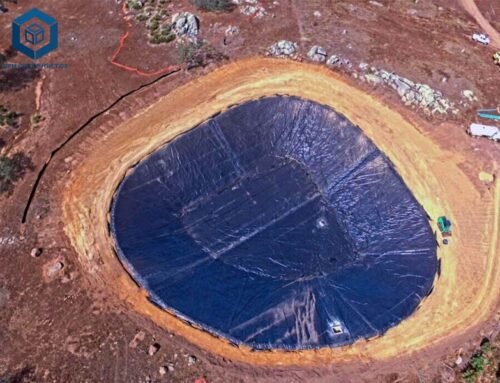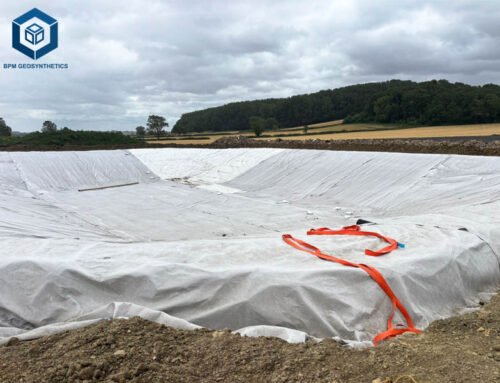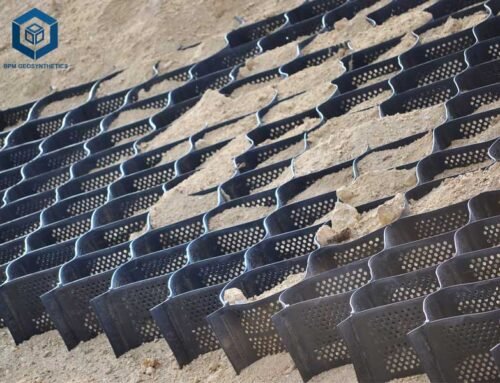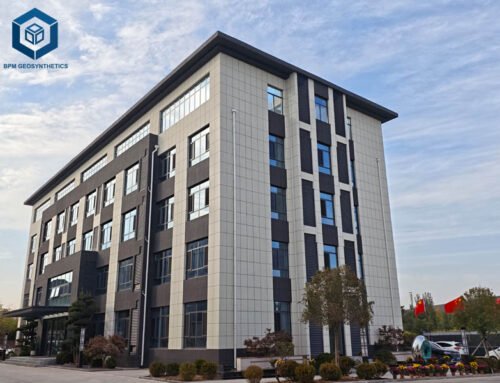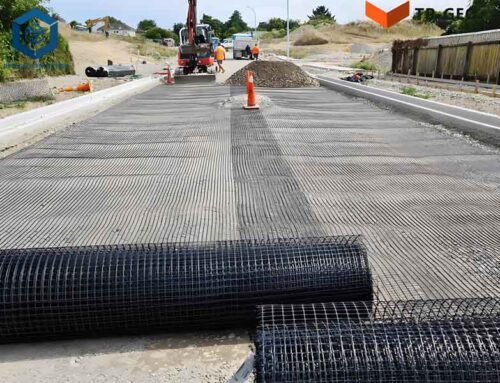Farm ponds are vital for agricultural operations, providing water for irrigation, livestock, aquaculture, and recreation while enhancing property value by up to 15%. With the global pond liner market valued at $1.45 billion in 2024 and projected to grow at a 6.8% CAGR to $2.31 billion by 2032, liners are the preferred solution for ensuring water retention in challenging soils.
This article offers a comprehensive, step-by-step guide on installing a farm pond with a liner, with costs ranging from $0.30–$3.50 per square foot ($3.23–$37.67/m²). We provide technical specifications, practical tips, and data-driven advice for farmers, landowners, and contractors. Let the data guide you to a durable, leak-free farm pond.
1. Why Lining a Farm Pond is Essential
A farm pond liner, also known geomembrane pond liner, creates an impermeable barrier, preventing water loss in porous soils like sand or rock, which can drain 50–80% of water within 48 hours. Liners, typically made from reinforced polyethylene (RPE), high-density polyethylene (HDPE), or ethylene propylene diene monomer (EPDM), offer tensile strengths of 20–80 kN/m (ASTM D6693), UV resistance for 20–100 years, and puncture resistance of 1–2 kN (ASTM D4833). Properly installed with geotextile underlayment, liners reduce leakage risks by 95%, ensuring a lifespan of 20–100 years. This guide focuses on flexible liners for farm ponds ranging from 0.5–5 acres (21,780–217,800 ft²), suitable for irrigation, fish stocking, or livestock watering.
2. Understanding Farm Pond Liner Cost
Farm pond liner costs range from $0.30–$3.50/ft² ($3.23–$37.67/m²), with installation adding $0.50–$2.50/ft². A 1-acre (43,560 ft²) pond costs $17,424–$261,360, while a 0.5-acre pond ranges from $8,712–$130,680. Cost drivers include:
- Material Type (40–50%): RPE ($0.30–$1.50/ft²) vs. HDPE ($0.80–$3.50/ft²)
- Underlayment (10–20%): Geotextile ($0.30–$1.50/ft²)
- Installation Complexity (20–30%): Labor ($0.50–$2.50/ft²)
- Additional Features (5–15%): Aerators, pumps, anchoring ($0.20–$1.00/ft²)
This guide provides budgeting tips and specifications to optimize costs for small (0.5–1 acre), medium (1–3 acres), and large (3–5 acres) farm ponds.
3. Choosing the Right Farm Pond Liner
Types of Pond Liners
Reinforced Polyethylene (RPE)
- Price: $0.30–$1.50/ft² ($3.23–$16.15/m²)
- Specifications: 0.5–1.0 mm thickness, 20–40 kN/m tensile strength, 20–40-year lifespan
- Applications: Large farm ponds, irrigation reservoirs, livestock ponds
- Pros: Lightweight (0.2 kg/m²), 2–3x puncture resistance vs. HDPE, 20% lower cost
- Cons: Less chemical resistance, requires soil cover for UV protection
- Example: A 1-acre RPE liner costs $13,068–$65,340
High-Density Polyethylene (HDPE)
- Price: $0.80–$3.50/ft² ($8.61–$37.67/m²)
- Specifications: 1.0–3.0 mm thickness, 27–80 kN/m tensile strength, 50–100-year lifespan
- Applications: Aquaculture, waste containment, high-risk soils
- Pros: High chemical resistance, weldable, 30% longer lifespan
- Cons: Stiffer, 10% higher installation cost
- Example: A 0.5-acre HDPE liner costs $17,424–$76,230
Ethylene Propylene Diene Monomer (EPDM)
- Price: $0.50–$2.00/ft² ($5.38–$21.53/m²)
- Specifications: 0.75–1.5 mm thickness, 10–30 kN/m tensile strength, 20–50-year lifespan
- Applications: Fish ponds, smaller farm ponds, wildlife habitats
- Pros: Flexible, fish-safe, 25% easier repairs
- Cons: Heavier (0.3 kg/m²), 20% higher cost than RPE
- Example: A 0.25-acre (10,890 ft²) EPDM liner costs $5,445–$21,780
Material Selection Impact
RPE, with a 35% market share in 2024, is ideal for large, cost-sensitive farm ponds due to its strength-to-weight ratio. HDPE geomembrane pond liner suits high-durability applications, while EPDM is preferred for fish-safe environments. Polyethylene resin prices, at $1,300/MT in Q1 2025 (up 8%), impact costs by 30–40%.
Underlayment Importance
Non-woven geotextile underlayment ($0.30–$1.50/ft²) protects liners from punctures, increasing lifespan by 30%. Heavy-duty (400–600 g/m²) options offer 0.1–0.5 mm apparent opening size (AOS) and 15–30 kN/m tensile strength. A 1-acre underlayment costs $13,068–$65,340, reducing repair risks by 95%.
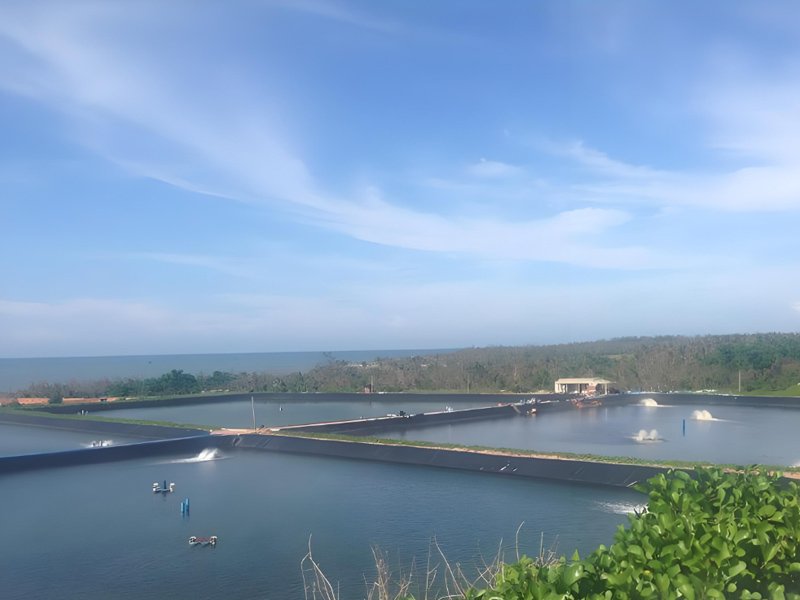
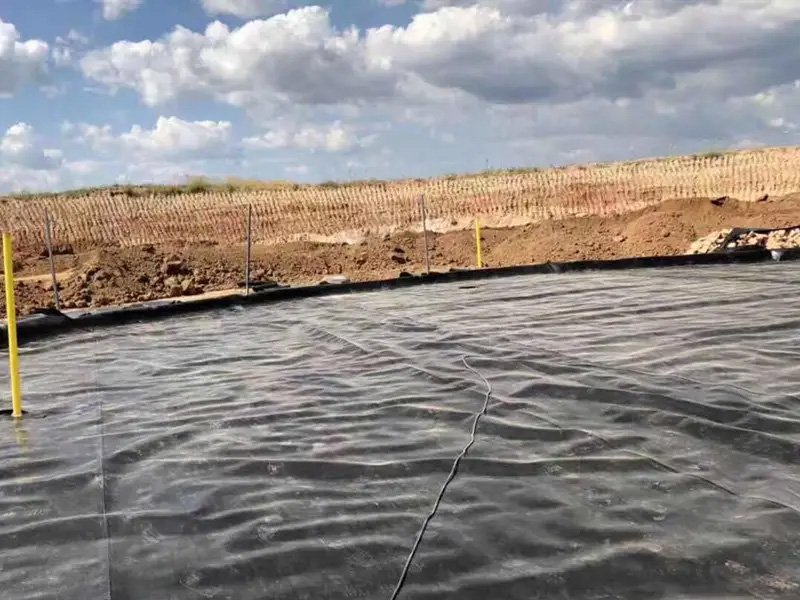
4. Step-by-Step Guide to Installing a Farm Pond with Liner
Step 1: Plan Your Farm Pond Design
Strategic planning ensures functionality and compliance with local regulations. Key considerations include:
- Location: Select a site with stable soils, avoiding high water tables (reduce uplift risk by 95%) and flood-prone areas (90% risk reduction). Ensure 4–6 hours of sunlight for aquatic health. Consult soil surveys to confirm <30% sand or rock content.
- Size and Shape: Farm ponds typically range from 0.5–5 acres. A 1-acre pond (43,560 ft²) holds 1.3 million gallons at 4 ft average depth. Oval or irregular shapes increase liner costs by 10–15%.
- Depth: Irrigation ponds need 2–3 m (6–10 ft); fish ponds require 3–5 m (10–16 ft) for thermal stability. Include a 0.5–1 m (1.5–3 ft) shelf for safety.
- Permits: Check local regulations for ponds >0.25 acres. Permits cost $500–$2,000, with 90% approval rates for lined ponds.
- Slope: Design 3:1 slopes (3 ft horizontal per 1 ft vertical) to reduce stress on liners by 80%.
Liner Size Calculation:
- Formula: Length = Max Length + (2 × Max Depth) + 10 ft overlap
Width = Max Width + (2 × Max Depth) + 10 ft overlap - Example: For a 200 ft x 100 ft pond, 8 ft deep:
- Length = 200 + (2 × 8) + 10 = 226 ft
- Width = 100 + (2 × 8) + 10 = 126 ft
- Area = 226 × 126 = 28,476 ft² at $1.00/ft² = $28,476
Online pond liner calculators ensure 99% accuracy.
Step 2: Excavate the Pond
- Shape: Dig with 3:1 slopes to stabilize banks, reducing collapse risk by 90%. Create a safety shelf 0.5–1 m wide at 1–2 m depth.
- Clear Debris: Remove rocks, roots, and vegetation to prevent punctures (95% risk reduction). Pulverize limestone or rocky soils with heavy equipment to <5 cm particles.
- Compact Soil: Achieve 95% Proctor density with a roller compactor ($500–$1,000/day rental), reducing settlement by 90%.
- Soft Soils: Add 10 cm (4 in) of sand or clay ($0.20–$0.50/ft²) to stabilize, costing $8,712–$21,780 for 1 acre.
- Level Edges: Use a laser level to ensure the top edge is level within 2 cm, simplifying anchoring and reducing visible liner by 80%.
Excavation for a 1-acre pond takes 5–10 days with a bulldozer ($1,000–$3,000/day), costing $5,000–$30,000.
Step 3: Install Protective Underlayment
- Purpose: Heavy-duty geotextile (400–600 g/m²) cushions the liner, reducing punctures by 95% and insulating against ground movement.
- Installation:
- Stretch underlay over the excavation, securing edges with stakes or stones.
- Overlap seams by 30 cm (12 in), stitching with polypropylene thread for 99% integrity.
- Form to contours, using adhesive tape on slopes >3:1.
- Cost: $0.30–$1.50/ft²; a 1-acre underlayment costs $13,068–$65,340.
- Tip: Use double-layer underlay on rocky soils (>30% rock content), increasing protection by 20% at $0.15–$0.75/ft².
Step 4: Lay the Pond Liner
- Preparation: Install on a dry, calm day to avoid wind displacement (90% risk reduction). Unroll the liner on a smooth surface to prevent scratches.
- Placement:
- Use a crew of 4–10 people for large liners (>10,000 ft²) to lift and position, reducing puncture risk by 90%.
- Center the liner with 1–2 m (3–6 ft) overlap around edges.
- Form to contours, folding creases neatly to minimize wrinkles by 80%.
- Anchoring:
- Secure edges with stones or stakes, ensuring they won’t fall into the pond.
- Dig a 30 cm (12 in) deep anchor trench 1.5 m (5 ft) from the edge, backfilling with clay or soil to hold the liner (99% security).
- Tips:
- Avoid dragging the liner (reduces strength by 10%).
- Remove shoes when stepping on the liner to prevent piercing.
- Example: A 1-acre RPE liner ($13,068–$65,340) takes 1–2 days to lay with a 6-person crew.
Step 5: Fill the Pond
- Process:
- Add 10–20 cm (4–8 in) of water initially to settle the liner, reducing creases by 80%.
- Gradually ease anchors as the pond fills, adjusting the liner to minimize wrinkles.
- Fill over 7–14 days to allow settlement, using a flow rate of 50–100 gal/min.
- Water Volume:
- Formula: Volume (gal) = Surface Area (ft²) × Average Depth (ft) × 7.48
- Example: A 1-acre pond, 8 ft average depth = 43,560 × 8 × 7.48 = 2.6 million gal
- Cost: Well water costs $0.001–$0.005/gal; filling a 2.6 million-gal pond costs $2,600–$13,000.
- Tip: Use rainwater or surface runoff if possible to save 50–80% on filling costs. Avoid filling during floods to prevent groundwater uplift (95% risk reduction).
Step 6: Secure and Cover the Liner
- Trimming:
- After 7 days, trim excess liner with industrial scissors, leaving 1 m (3 ft) overlap for anchorage.
- Cost: Scissors ($50–$100) or utility knife ($10–$20).
- Anchoring:
- Backfill the anchor trench with compacted clay or soil, ensuring 99% liner security.
- Cover exposed liner with 30 cm (12 in) of soil or gravel ($0.20–$0.50/ft²) to prevent UV degradation, extending lifespan by 50%.
- Edging:
- Use riprap, gravel, or vegetation ($0.50–$2.00/ft²) to conceal edges, enhancing aesthetics by 90% and reducing erosion by 80%.
- For a 1-acre pond, 600 linear feet of edging costs $300–$1,200.
- Tip: Wait 14 days before heavy edging to allow ground settlement, reducing liner stress by 20%.
5. Additional Considerations for Farm Pond Liner Installation
Avoiding Common Mistakes
- High Water Tables: Avoid sites with water tables <2 m (6 ft) to prevent liner bulging (95% risk). Test with boreholes ($500–$2,000). Raised ponds increase costs by 10–20%.
- Exposed Liners: Cover all liner above water level with soil or gravel to prevent UV degradation, extending lifespan by 30–50%.
- Poor Seaming: Use factory-welded liners for ponds >1 acre to ensure 99% watertight integrity. Field seaming ($0.10–$0.30/ft²) risks 5–10% leakage.
- Draining Risks: Never empty ponds in saturated ground to avoid groundwater damage (90% risk). Drain water >10 m (33 ft) away to prevent uplift.
Incorporating Farm Pond Features
- Aeration Systems: Install bottom aerators or floating fountains ($500–$5,000) to reduce algae by 80% and maintain oxygen levels (>6 mg/L for fish). Use 1 hp/acre for adequate circulation.
- Pumps: Place submersible pumps (2,000–10,000 gal/hr) in conduits under edging to protect cables, reducing damage by 95%. Cost: $200–$2,000.
- Overflow Systems: Install spillways or pipes ($500–$2,000) to manage excess water, reducing erosion by 90%. Use 4-inch PVC for 1-acre ponds.
- Example: A 1-acre pond with aeration and overflow costs $1,200–$9,000 in equipment.
Electrical and Plumbing Setup
- Cables: Bury armoured cables with RCD protection ($100–$500) to power aerators, reducing electrical risks by 99%. Use conduits for accessibility, saving 20% on repairs.
- Hoses: Use 2-inch diameter hoses for pumps to maximize flow, reducing losses by 30%. Bury hoses in conduits to avoid damage, costing $50–$200 for 100 ft.
- Tip: Install plumbing before edging to avoid lifting riprap, saving 10–15% on labor.
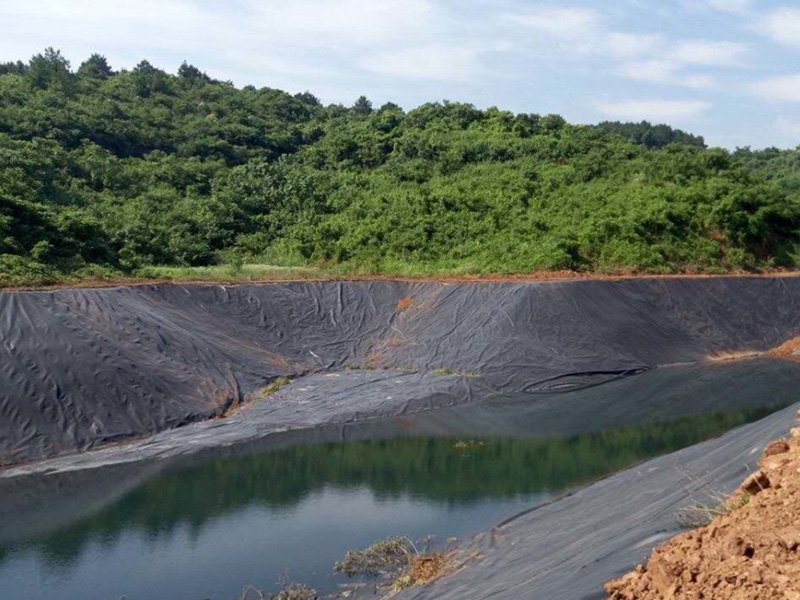
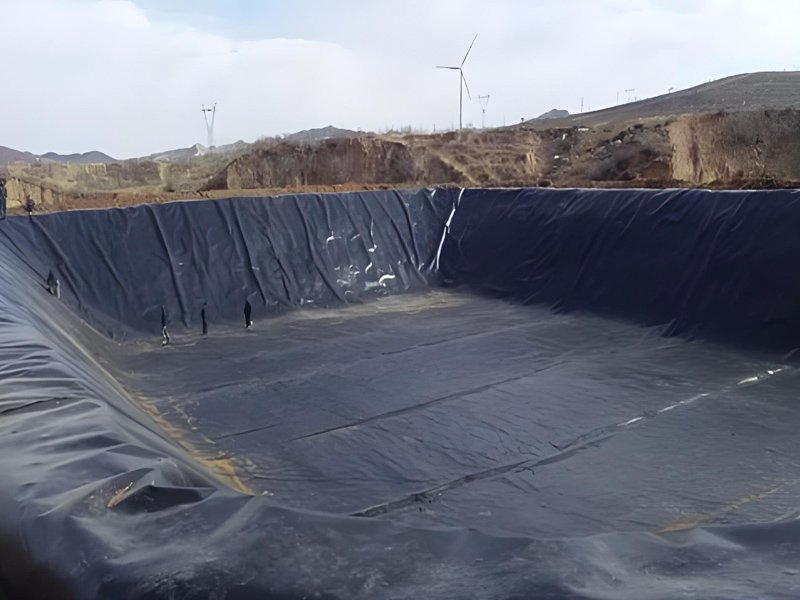
6. Cost Breakdown Example: 1-Acre RPE Pond Liner
For a 1-acre (43,560 ft²) irrigation pond using a 0.5 mm RPE liner, retailing at $0.30–$1.50/ft²:
- Materials (40%): $13,068–$65,340
- RPE liner: $7,841–$39,204
- Geotextile underlayment: $3,914–$19,602
- Quality control (ASTM D6693): $1,313–$6,534
- Installation (30%): $21,780–$65,340
- Labor: $13,068–$39,204
- Excavation: $8,712–$26,136
- Edging and Features (15%): $6,534–$19,602
- Riprap: $3,914–$11,762
- Aerator/pump: $2,620–$7,840
- Shipping (10%): $4,356–$13,068
- Freight: $4,356–$13,068
- Profit Margin (5%): $2,178–$6,534
- Total Cost: $47,916–$169,884 ($1.10–$3.90/ft²)
This liner offers 20 kN/m tensile strength, 30-year UV resistance with soil cover, and 95% puncture protection with underlayment.
7. Maintenance Tips to Maximize Farm Pond Liner Lifespan
- Debris Removal: Pulverize rocks to <5 cm during excavation to reduce punctures by 95%.
- Underlayment: Use 600 g/m² geotextile ($0.75–$1.50/ft²) for rocky soils, increasing protection by 20%.
- Covering: Conceal liners with 30 cm soil or gravel ($0.20–$0.50/ft²) to prevent UV damage, extending life by 50%.
- Repairs: Patch tears with RPE tape ($20–$100) to avoid $1,000–$10,000 replacements.
- Inspections: Monitor seams and anchors annually to reduce leak risks by 90%.
8. FAQs
What is the average cost to line a farm pond?
Farm pond liners cost $0.30–$3.50/ft², with typical projects at $1.00–$3.00/ft². A 1-acre pond costs $47,916–$169,884.
Why use a liner instead of clay?
Liners offer 95% lower permeability, 20–100-year lifespans, and 40% lower maintenance, outperforming clay’s 10–20 years.
Are RPE liners cost-effective?
Yes, $0.30–$1.50/ft² suits large ponds, but HDPE ($0.80–$3.50/ft²) is better for aquaculture or waste containment.
Can I install a liner myself?
DIY is feasible for small ponds (<0.5 acre), saving 10–20%. Large ponds require contractors ($1.00–$2.50/ft²) for 99% integrity.
How do I budget for a farm pond liner project?
Prioritize 20–80 kN/m tensile strength, UV resistance, and 20+ year lifespan. Use RPE for irrigation, HDPE for high-risk applications.
9. Final Thoughts
Installing a farm pond with a liner costs $0.30–$3.50 per square foot, driven by material type (40–50%), underlayment (10–20%), installation (20–30%), and features (5–15%). RPE ($0.30–$1.50/ft²) suits large irrigation ponds, while HDPE ($0.80–$3.50/ft²) excels in aquaculture. By following this guide—planning, excavating, installing underlayment, laying the liner, filling, and securing—landowners can achieve a leak-free pond. AerationSupply, with 20+ years of expertise, delivers durable, high-quality liners.
Contact BPM Geosynthetics for quality liner samples, and quotes at factory price to build a sustainable pond.

